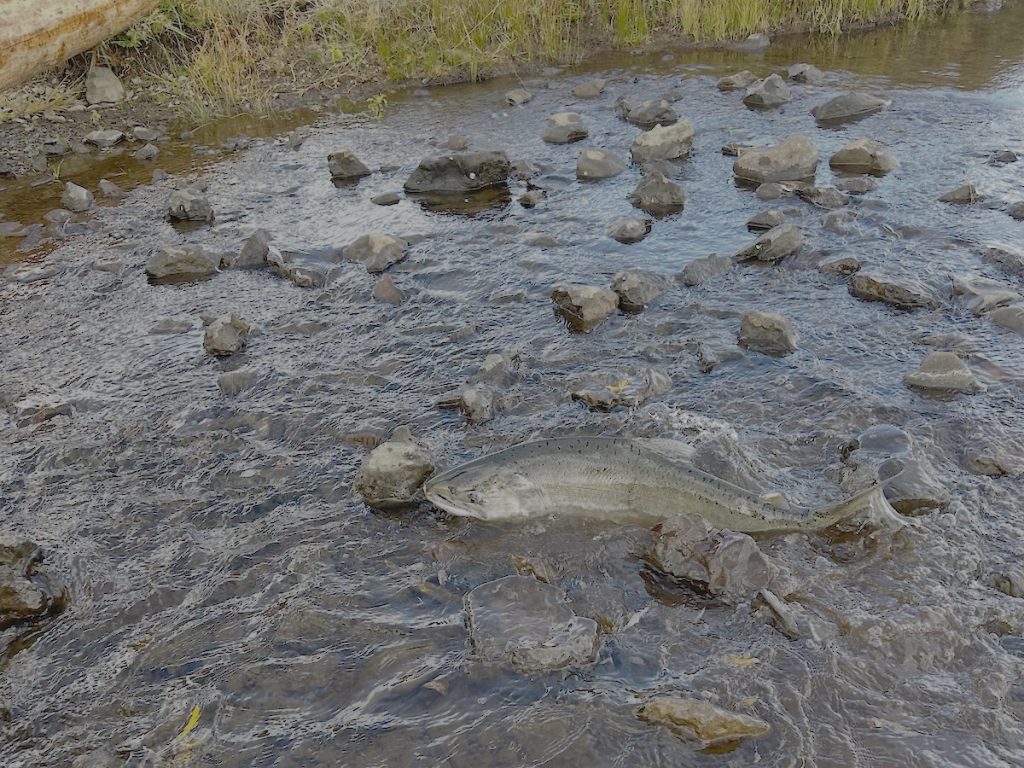Salmon Spotted Far Upstream After Historic Klamath River Dam Removal
4 min read
A fall-run Chinook salmon seen on Oct. 16, 2024, in a tributary of the Klamath River after removal of the dams, marking the first fish to return since 1916. Mark Hereford, Oregon Department of Fish and Wildlife
Founded in 2005 as an Ohio-based environmental newspaper, EcoWatch is a digital platform dedicated to publishing quality, science-based content on environmental issues, causes, and solutions.
Less than two months following the removal of four hydroelectric dams along the Klamath River, some of its salmon have swum upstream in Oregon to start spawning for the first time in over a century.
The first salmon was spotted October 3 on sonar, swimming through the former site of Siskiyou County’s Iron Gate Dam, reported the San Francisco Chronicle. Ever since that initial sighting, scientists say dozens to maybe hundreds of Chinook salmon have swum through the site — the southernmost of the four.
“The salmon remember,” Frankie Myers, vice chairperson of the Yurok Tribe, told the San Francisco Chronicle.
The purpose of the $500 million project was to restore the river’s natural flow and revive wildlife — including the salmon — in the Klamath River basin.
Since the dams were dismantled, scientists from Tribes, conservation organizations and state and federal governments have been watching for fish swimming by the former dam sites using video stations, sonar cameras and ground crews.
California state biologists have seen salmon swimming in creeks that had been blocked by the dams decades earlier, preventing the fish from accessing their ancestral spawning grounds, the Los Angeles Times reported.
“It’s amazing,” said fisherman Ron Reed, a member of the Karuk Tribe, as reported by the Los Angeles Times. “That’s what we’ve prayed for.”
Indigenous activists and leaders, like Reed, campaigned for decades for the removal of the dams.
Reed wasn’t surprised at how fast the fish have moved back upriver into their traditional creek beds.
“They’re very adept and very resilient,” said Reed. “And the fact that the fish are going up above the dams now, to the most prolific spawning and rearing habitat in North America, definitely shines a very bright light on the future. Because with those dams in place, we were looking at extinction.”
In addition to preventing salmon from reaching their spawning areas, the dams degraded the water quality of the river, contributing to outbreaks of disease and toxic algae blooms that sometimes killed great numbers of fish.
PacifiCorp agreed to remove the dams after discovering the cost would be lower than complying with current environmental standards. It was the biggest dam removal ever in the U.S.
The salmon can now swim more than 400 miles in the Klamath River and its tributaries.
Reed said the fall-run Chinook he and other Karuk Tribe members have been catching appear healthy and strong, “so much more beautiful this year.”
“The health and wellness of our people in the communities are so dependent upon the fish,” Reed said. “This really brings positive energy and hope for the future.”
Morgan Knechtle, a California Department of Fish and Wildlife senior environmental scientist who has participated in the surveys, said they have seen the salmon spawning successfully in the river.
“They’re doing what we had hoped,” Knechtle said, as the Los Angeles Times reported. “It looks like fish are adapting well and doing just what they’ve been doing for many, many thousands of years.”
Biologists are planning to track how many of the fish spawn and die over the coming couple of months.
“Because of Klamath River dam removal, salmon can return to the Upper Klamath Basin in Oregon for the first time in over 100 years. This will help restore salmon runs for Tribes up and down the river, including the Klamath Tribes in Oregon,” said Lee Rahr, Sustainable Northwest’s vice president of programs, in a press release from American Rivers.
On October 2, Klamath River Renewal Corporation — a nonprofit — announced that all dam removal work was complete. Two other dams are still in operation further upstream in Oregon.
Restoration of the Klamath River watershed — including native plant seeds being scattered by the Yurok Tribe — will continue for years to come.
“The river takes care of us, and we take care of the river,” said Yurok Tribe Chairperson Joseph L. James, as reported by the Los Angeles Times. “Our salmon have returned home.”
Subscribe to get exclusive updates in our daily newsletter!
By signing up, you agree to the Terms of Use and Privacy Policy & to receive electronic communications from EcoWatch Media Group, which may include marketing promotions, advertisements and sponsored content.





